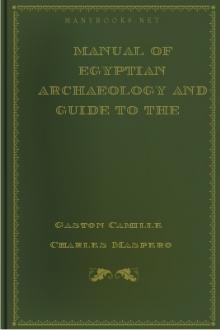Ancient America, in Notes on American Archaeology by John D. Baldwin (best thriller books to read .TXT) 📕

"It is in the form of a serpent, upward of 1000 feet in length, extended i
Read free book «Ancient America, in Notes on American Archaeology by John D. Baldwin (best thriller books to read .TXT) 📕» - read online or download for free at americanlibrarybooks.com
- Author: John D. Baldwin
- Performer: -
Read book online «Ancient America, in Notes on American Archaeology by John D. Baldwin (best thriller books to read .TXT) 📕». Author - John D. Baldwin
We have no measure of the time, no clew to the old dates, nothing whatever, beyond such considerations as I have stated, to warrant even a vague hypothesis. It can be seen clearly that the beginning of this old civilization was much older than the earliest great cities, and, also, that these were much more ancient than the time when any of the later built or reconstructed cities whose relics still exist, were left to decay. If we suppose Palenque to have been deserted some six hundred years previous to the Spanish Conquest, this date will carry us back only to the last days of its history as an inhabited city. Beyond it, in the distant past, is a vast period, in which the civilization represented by Palenque was developed, made capable of building such cities, and then carried on through the many ages during which cities became numerous, flourished, grew old, and gave place to others, until the long history of Palenque itself began.
Those who have sought to discredit what is told of the Aztec civilization and the empire of Montezuma have never failed to admit fully the significance of Copan, Palenque, and Mitla. One or two writers, pursuing the assumption that the barbarous tribes at the north and the old Mexicans were of the same race, and substantially the same people, have undertaken to give us the history of Montezuma’s empire “entirely rewritten,” and show that his people were “Mexican savages.” In their hands Montezuma is transformed into a barbarous Indian chief, and the city of Mexico becomes a rude Indian village, situated among the islands and lagoons of an everglade which afforded unusual facilities “for fishing and snaring birds.” One goes so far as to maintain this with considerable vehemence and amusing unconsciousness of absurdity. He is sure that Montezuma was nothing more than the principal chief of a parcel of wild Indian tribes, and that the Pueblos are wild Indians changed to their present condition by Spanish influence. There is something in this akin to lunacy.
But this topic will receive more attention in another place. I bring it to view here because those who maintain so strangely that the Aztecs were Indian savages, admit all that is claimed for the wonderful ruins at the south, and give them a very great antiquity. They maintain, however, that the civilization represented by these ruins was brought to this continent in remote pre-historic times by the people known as Phœnicians, and their method of finding the Phœnicians at Palenque, Copan, and every where else, is similar in character and value to that by which they transform the Aztec empire into a rude confederacy of wild Indians.
DISTINCT ERAS TRACED.It is a point of no little interest that these old constructions belong to different periods in the past, and represent somewhat different phases of civilization. Uxmal, which is supposed to have been partly inhabited when the Spaniards arrived in the country, is plainly much more modern than Copan or Palenque. This is easily traced in the ruins. Its edifices were finished in a different style, and show fewer inscriptions. Round pillars, somewhat in the Doric style, are found at Uxmal, but none like the square, richly-carved pillars, bearing inscriptions, discovered in some of the other ruins. Copan and Palenque, and even Kabah, in Yucatan, may have been very old cities, if not already old ruins, when Uxmal was built. Accepting the reports of explorers as correct, there is evidence in the ruins that Quirigua is older than Copan, and that Copan is older than Palenque. The old monuments in Yucatan represent several distinct epochs in the ancient history of that peninsula. Some of them are kindred to those hidden in the great forest, and remind us more of Palenque than of Uxmal. Among those described, the most modern, or most of these, are in Yucatan; they belong to the time when the kingdom of the Mayas flourished. Many of the others belong to ages previous to the rise of this kingdom; and in ages still earlier, ages older than the great forest, there were other cities, doubtless, whose remains have perished utterly, or were long ago removed for use in the later constructions.
The evidence of repeated reconstructions in some of the cities before they were deserted has been pointed out by explorers. I have quoted what Charnay says of it in his description of Mitla. At Palenque, as at Mitla, the oldest work is the most artistic and admirable. Over this feature of the monuments, and the manifest signs of their difference in age, the attention of investigators has lingered in speculation. They find in them a significance which is stated as follows by Brasseur de Bourbourg: “Among the edifices forgotten by time in the forests of Mexico and Central America, we find architectural characteristics so different from each other, that it is as impossible to attribute them all to the same people as to believe they were all built at the same epoch.” In his view, “the substructions at Mayapan, some of those at Tulha, and a great part of those at Palenque,” are among the older remains. These are not the oldest cities whose remains are still visible, but they may have been built, in part, upon the foundations of cities much more ancient.
NOTHING PERISHABLE LEFT.No well considered theory of these ruins can avoid the conclusion that most of them are very ancient, and that, to find the origin of the civilization they represent, we must go far back into the “deeps of antiquity.” On all the fields of desolation where they exist, every thing perishable has disappeared. Wooden lintels are mentioned, but these can hardly be regarded as constituting an exception when the character of the wood, and the circumstances that contributed to their preservation, are considered. Moreover, wooden lintels seem to have been peculiar to Yucatan, where many of the great edifices were constructed in the later times, and some of them of perishable materials. Every where in the older ruins, nothing remains but the artificial mounds and foundations of earth, the stone, the cement, the stucco hard as marble, and other imperishable materials used by the builders.
If the edifices had all been made of wood, there would now be nothing to show us that the older cities had ever existed. Every trace of them would have been obliterated long before our time, and most of them would have disappeared entirely long before the country was seen by the Spaniards. The places where they stood, with no relics save the mounds and pyramidal platforms, would resemble the works of our Mound-Builders, and not a few “sound historical critics” would consider it in the highest degree absurd to suggest that cities with such structures have ever existed there. Under the circumstances supposed, how wisely skepticism could talk against a suggestion of this kind at Copan, Mitla, or Palenque! and how difficult it would be to find a satisfactory answer to its reasonings! Nevertheless, those mysterious structures have not wholly disappeared, and we can easily understand that there was a time when large areas connected with them were covered with buildings of a less durable character.
I have referred to a writer who maintains, with more vehemence than candor, that the Aztecs, and all the other people found in the country, were “savages” not greatly different from the wild Indians farther north, while he admits the significance and great antiquity of these ruins. His conception of their antiquity is somewhat extreme, for he says they must have existed “for thousands of years” when the Spaniards arrived. If he had maintained that civilized communities were there “thousands of years” previous to that time, developing the skill in architecture, decoration, and writing, to which the monuments bear witness, it might be possible to agree with him. Some of us, however, would probably stipulate that he should not count too many “thousands,” nor claim a similar antiquity for the ruins now visible. It is not easy to suppose that any of these old monuments, with their well-preserved sculptures and inscriptions, represent the first period of the ancient history they suggest, nor that they have existed as ruins many “thousands of years,” for the climate of Mexico and Central America does not preserve such remains like that of Egypt.
Nevertheless, some of them must be very old. The forest established since the ruin began, the entire disappearance of every thing more perishable than stone, the utter oblivion which veiled their history in the time of Montezuma, and probably long previous to his time, all these facts bear witness to their great antiquity. In many of them, as at Quirigua and Kabah, the stone structures have become masses of débris; and even at Copan, Palenque, and Mitla, only a few of them are sufficently well preserved to show us what they were in the great days of their history. Meanwhile, keep in mind that the ruined cities did not begin their present condition until the civilization that created them had declined; and, also, that if we could determine exactly the date when they were deserted and left to decay, we should only reach that point in the past where their history as inhabited cities was brought to a close.
Take Copan, for instance. This city may have become a ruin during the time of the Toltecs, which began long before the Christian era, and ended some five or six centuries probably before the country was invaded by Cortez. It was built before their time, for the style of writing, and many features of the architecture and ornamentation, show the workmanship of their predecessors, judging by the historical intimations found in the old books and traditions. We may suppose it to have been an old city at the time of the Toltec invasion, although not one of the first cities built by that more ancient and more cultivated people by whom this old American civilization was originated. The present condition of the monuments at Quirigua is still more suggestive of great age.
“THE OLDEST OF CIVILIZATIONS.”Some investigators, who have given much study to the antiquities, traditions, old books, and probable geological history of Mexico and Central America, believe that the first civilization the world ever saw appeared in this part of Ancient America, or was immediately connected with it. They hold that the human race first rose to civilized life in America, which is, geologically, the oldest of the continents; and that, ages ago, the portion of this continent on which the first civilizers appeared was sunk beneath the waters of the Atlantic Ocean. Usually the ingulfing of this portion of the land is supposed to have been effected by some tremendous convulsion of nature; and there is appeal to recollections of such a catastrophe, said to have been preserved in the old books of Central America, and also in those of Egypt, from which Solon received an account of the lost Atlantis.
According to this hypothesis, the American continent formerly extended from Mexico, Central America, and New Granada far into the Atlantic Ocean toward Europe and Africa, covering all the space now occupied by the Caribbean Sea, the Gulf of





Comments (0)